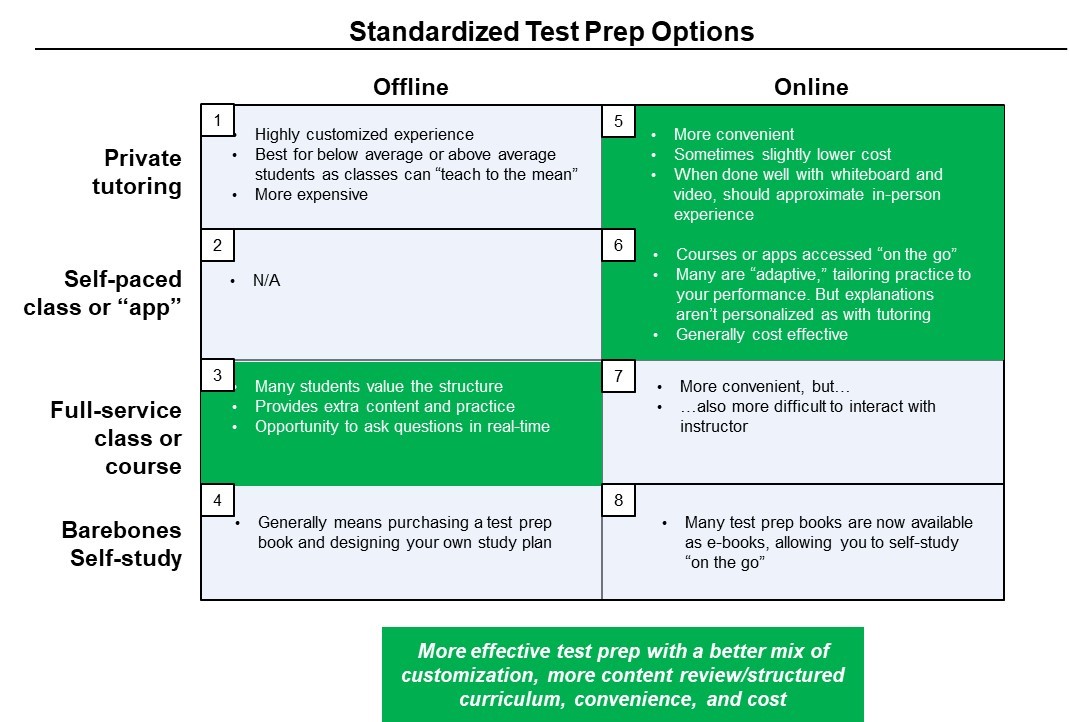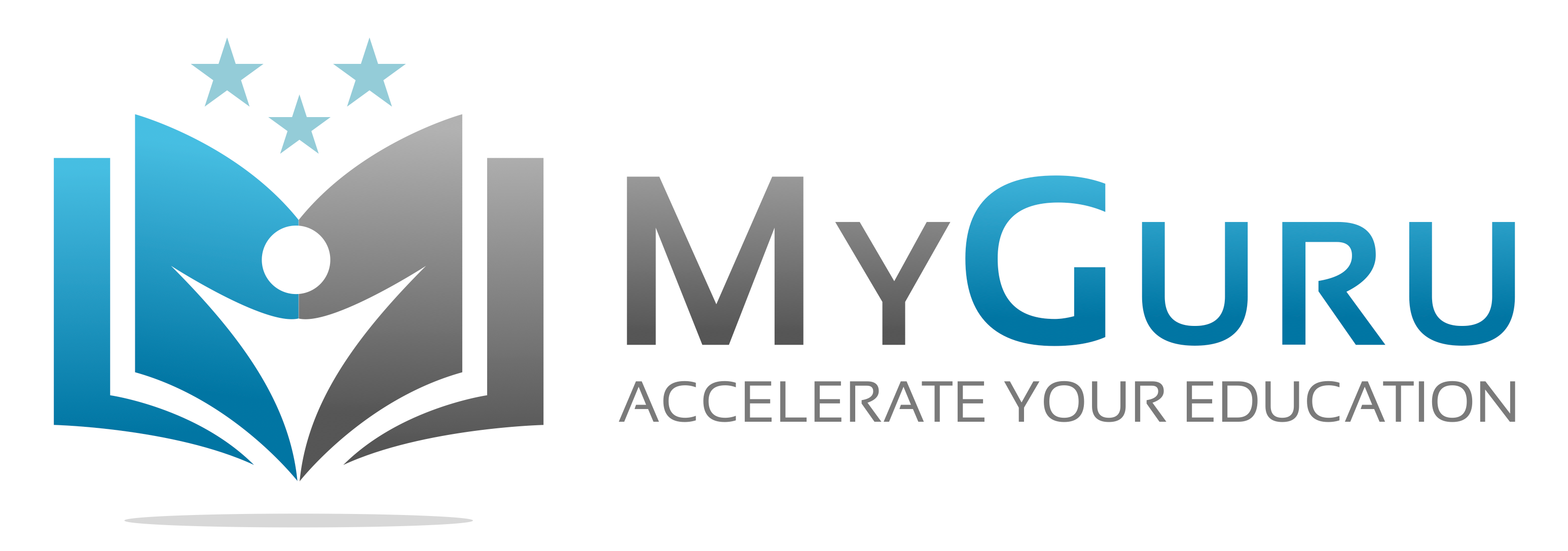Thanks for visiting this section of MyGuru's web-site, which is dedicated to preparing for the GRE. We are just now getting started with content development for this...
GRE/GMAT Study Planning Fundamentals: Choosing a GRE Preparation Method
This is the first in a multipart series on how to go about studying for the GRE or GMAT. We don’t plan on going into detail on specific concepts covered on the GRE or specific test-taking strategies in this series. Instead, the intention is to cover higher level, foundational issues around preparing for these exams, such as what type of support to get, what materials to use, what mindset to cultivate, etc. This article is being posted on our GRE blog, but we’ll switch from GRE to GMAT over time, as the concepts are broadly applicable to both exams.
To start, let’s point out that we are often asked what materials we recommend our students use to prepare for the GRE. We generally have a clear answer to this question (it focuses on using the Official Guide to the GRE and a few other free or low cost materials), but before exploring that question in the next installment of our “GRE/GMAT Study Planning Fundamentals” series, we need to answer a higher-level question. What is your preferred approach to studying for the GRE in the first place?
You need to match your materials with the overall approach you are most comfortable with and which will work best for you. So, in this initial article, we’ll explore various approaches to preparing for the GRE.
There are two basic, initial dimensions to the question of how to prepare for the GRE: “offline vs. online” and “type of support.”
Offline vs. online is almost self-explanatory. It means, will you primarily be working offline with physical books, potentially meeting someone in-person to review, or will you be heavily leveraging the internet and using an online course or app?
The “type of support” dimension breaks down into the following options:
- Self-study using a test prep book, such as the official guide mentioned above, or something from Princeton Review, Barron’s, Kaplan, or many other sources
- Self-paced course or “app” – good examples here would be GRE prep from Magoosh, Dominate the GRE, or PrepScholar
- Full service real-time class or course
- Private GRE tutor
The “right” approach to studying for the GRE is partially a function of personal preference, particularly when it comes to offline vs. online. But, it’s also a function of the type of student you are and your particular strengths and weaknesses. The below matrix may help you think through your options.

Let’s make our way through the above matrix and explore the pros and cons of these approaches. Box 1 will be the upper left (private tutoring completed offline), and then box 2 will be the one below it. So, box 4 is self-study completed offline. We’ll then consider box 5 to be private tutoring completed online, and box 8 to be the lower right, or self-study completed online.
As we evaluate each box, we’ll be concerned with ultimate effectiveness for various types of students (i.e., ability of the approach to lead to a higher GRE score), but also cost and convenience.
Let’s start by discussing Box 1, or private tutoring completed offline and in-person, and Box 5, private tutoring completed online over the internet. We’ll compare these boxes to each other, as well as to the rest of the matrix.
Private tutoring is probably the most customized way to prepare for the GRE. IF you have a good GRE tutor, he or she will help you develop a customized plan, explain concepts in ways that more quickly make sense to you, and function as a mentor to accelerate your GRE prep. On the other hand, 1-1 GRE tutoring can be very expensive, and because each tutor has his or her own approach, there is a downside that involves a lack of structure and too much time spent on this or that topic, whereby a student ends up feeling like they have spent a lot of money and spent a lot of time, but still don’t know all they need to know to get a high score.
In general, though, with private GRE tutoring, assuming you have a good or very good GRE tutor, you’ll get an approach tailored to your unique situation (timing, strengths, etc.) that is expensive but effective in building your skills and preparing you for test day. If you are an average test taker and just looking for an average score or above average score, this option could be less attractive to you. A class or an “app,” or even self-study, may strike a better balance of effectiveness, cost, and convenience.
Classes tend to “teach to the average,” meaning they cover topics at a pace that makes sense for the average student.
However, this means that for someone who is really struggling, the class might be go too fast. But, for someone shooting for a 90th percentile score at a minimum, the same class might be going too slow. If you have spiky strengths and weaknesses, the class approach is also problematic. For the mathematically gifted but verbally challenged student, half the class is a waste, and the other half may progress too quickly. In all these cases, private tutoring, due to the customized approach, is a great option relative to classes. But for the average student, it’s a harder call.
If you compare private tutoring to a self-paced app (box 6) or self-study (4 or 8), the average student may just find that they must be extremely disciplined and hard working to prepare adequately on their own without support of a tutor or course/app to provide guidance on concepts and practice problems. But, self-study is clearly much less expensive. Our biased view, in part informed by the hundreds of hours the author of this article spent self-studying for the GMAT instead of getting a private tutor, is that the use of an app or private tutor is a good investment.
Regarding the online vs. offline question, or box 1 vs. 5, many students continue to feel like there is no substitute to sitting down with someone in-person to study or receive private tutoring. And it’s true that a lot is communicated through non-verbal cues, etc. However, I should note that the right type of online GRE tutoring, with a clear video and easy to use online whiteboard, can feel very much like an in-person experience. You see the tutor’s face, and he or she sees yours. You see the whiteboard, just like you’d see the paper. You are both looking at the same e-book, just as if you were looking at a physical book. When you consider these points, the fact that online tutoring is obviously more convenient (no travel, easier to fit into everyone’s schedule, etc.), the fact that online sessions can be recorded for later review, and the fact that the GRE is given online anyway, our view is that online tutoring is a better option than in-person tutoring (when done right, with an effective platform).
In part 2 of this article, we’ll review the rest of the matrix and explain why, in our view, boxes 3, 5, and 6 are the best approaches to preparing for the GRE for the majority of students.
